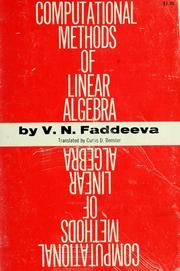Computational methods of linear algebra
Vera Nikolaevna. Faddeeva and Curtis D. Benster (tr)
Faddeeva, Vera Nikolaevna.; Curtis D. Benster (tr);
Computational methods of linear algebra
Dover Publications, 1959, 252 pages [hpb coll stn 50c]
topics: | math | linear-algebra
This book entered my consciousness when I encountered it at the Half-Price Books store at College Station around 1993. It cost me all of 50 c, and I looked upon it as a sort of dead background read. Across continents, it languished on the shelf.
Much later, when I took it up one day, it was intriguing to discover that in 1959, the terms "eigenvalue" / "eigenvector" had not yet been standardized; the translator calls them proper numbers and proper vectors of a matrix.
Even later, I realized that this text had become a classic. It is listed as the first text referred to by Golub and van Loan as "Classic" texts in linear algebra.
Several decades after the book had been hiding in my shelves, I realized that Vera Nikolaevna Faddeeva (1906-1983) was an woman, one of the early pioneering women mathematicians.
from the Translator's Note: I have replaced many of the Russian references with more accessible ones, and re-computed all of the principal tables, which I hope will thus be [more] reliable. p.vi
Contents
Preface Translator's note 1. Basic material from linear algebra 1 2. Systems of linear equations 63 3. The proper numbers and proper vectors of a matrix 147 Bibliography Danilevsky's method for eigen-computation: http://web.ist.utl.pt/~ist11038/compute/com/,eigen/FaddeevaDanil.pdf
bio
http://www-history.mcs.st-and.ac.uk/Biographies/Faddeeva.htmlVera Nikolaevna was born in Tambov, a town about 470 km south east of Moscow. In 1930, she married the mathematician Dmitrii Konstantinovich Faddeev [Faddeeva is her married name). The years during which Vera Nikolaevna was an undergraduate at Leningrad State University were ones of great difficulty for the academics at the university. During this period independent thinkers were persecuted and N M Gyunter, at that time President of the Leningrad Mathematical Society and a man with a reputation for courage and independent thought, was in great danger. In fact the Leningrad Mathematical Society was disbanded in 1930 following a proposal by the vice-president Vladimir Ivanovich Smirnov, in a successful attempt to save Gyunter's life and the lives of other mathematicians.
Background to the book
Reviewing Faddeeva's classic 1950 book Computational methods of linear algebra, G E Forsythe writes:- This is a textbook on numerical methods for solving finite systems of linear equations, inverting matrices, and calculating the eigenvalues of finite matrices, all with desk calculators. Although the book is far from exhaustive, the mathematical elegance, the breadth of material, and the number of error-free numerical examples make this by far the finest book to appear in the field. The first chapter of this book was translated into English for the National Bureau of Standards in the United States in 1952 and, in 1959, an English translation of the whole book was published. [12]:- The first chapter of this book forms a clear and well-written introduction to the elementary parts of linear algebra. The second chapter deals with numerical methods for the solution of systems of linear equations and the inversion of matrices, and the third with methods for computing characteristic roots and vectors of a matrix. Most of the important material in these domains is to be found here, and many numerical examples which illustrate the algorithms and point out their merits and deficiencies are given. The discussion is directed principally to the hand computer, and machine computation in the modern sense is hardly present, but the book must be regarded as a valuable guide for the worker in the general area of linear computation. Olga Taussky-Todd, after giving a similar guide to the contents, writes that the book will serve [13]:- ... a very useful purpose for researchers, as well as for teachers and students of numerical analysis, because of the clear presentation of the basic facts. Alston Householder [1] writes:- Each edition was, at the time of its appearance, by far the most complete and up-to-date treatment of the subject in print.
How to join Book Excerptise
To join book excerptise and contribute your scribblings here, just send us a first writeup with excerpts from your favourite book (and maybe a review). Format: plain text or wiki markup - please avoid MS word. Email with the subject line "first writeup : name-of-book" to (bookexcerptise [at-symbol] gmail). Your writeup will be circulated among the editors and should show up soon (under your name). Frequent contributors may be invited to to join the editorial team.
bookexcerptise is maintained by a small group of editors. your comments are always welcome at bookexcerptise [at-symbol] gmail. This article last updated on : 2013 Oct 01
